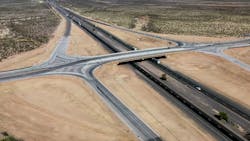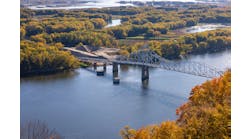The haters might say, “I can’t believe I-10/Houghton Road is so high on the list. It’s just an interchange reconstruction.” But anyone who says that is missing the bigger picture.
Thanks to a diverging diamond interchange (DDI), this project in Tucson, Arizona increased the daily capacity of traffic from 8,000 vehicles a day to 50,000. The $24.4 million interchange, the first DDI in southern Arizona and the second in the state, replaced a 50-year-old outdated two-lane bridge, which lacked separate left turn lanes and had caused extensive delays during peak hour traffic.
The DDI was selected by the Arizona Department of Transportation because fewer conflict points, particularly in left turn movements, make it one of the safest options. It also had lower construction costs, lower right-of-way impacts, the highest traffic accommodation and was enthusiastically supported by the public.
This project was one of the early submissions we received, and we were so impressed that we wrote about it in September to promote these awards.
The DDI will accommodate the anticipated growth, with projections indicating I-10 volumes will increase 50% by 2045. Similarly, Houghton Road expects substantial increases in traffic, with projections showing a 500% increase north of I-10 and a 200% increase south of I-10.
The new interchange includes a new I-10 overpass bridge, with four parallel entrance and exit ramps connecting with I-10. Houghton Road was widened to three through lanes in each direction north and south of I-10. It includes a dedicated, protected route across the bridge for pedestrians and cyclists, connecting existing trails and creating a convenient route for those traveling to the nearby fairgrounds.
Signal operations are simplified in a DDI because there is no need to allocate green light time specifically for left turn movements from the cross street to/from the ramps. Instead, left turns are made using free-flowing lanes.
The full DDI layout allows local traffic to shift to the left when the traffic signal is green, allowing motorists to turn directly more safely left onto entrance ramps without stopping at an additional traffic signal or having to wait for oncoming traffic to clear. Other features of the Houghton design include:
• A new 7-lane bridge designed by a subconsultant with pedestrian and bike lanes and full shoulders.
• Green pavement markings were painted in turn lanes to highlight where motorists are supposed to drive. Special signage and pavement markings and lighting at all ramps, crossroads, and the interchange guide both motorists, pedestrians, and cyclists.
• An aesthetic design included piers shaped to look like cacti, with desert colors throughout.
• Various turning movements throughout DDI accommodate large trucks.
• Crossover intersections accommodate special over height vehicles.
• Space to accommodate I-10 widening.
As part of the original design concept study, engineers researched similar DDI projects in other states to design Houghton Road, which was custom in many ways. For example, rather than using bridge abutments, the design called for full height retaining walls behind piers, a concept Stanley Consultants refined with its own adjustments on the mammoth South Mountain Freeway program, the largest in ADOT history. The design refinements are being copied on other projects in Arizona.
These pier-style exposed abutments are like a regular pier except for a bridge span on one side and an approach slab span and a mechanically stabilized earth (MSE) retaining wall on the other. The retaining walls simplify analysis, design, and detailing. The abutment primarily carries the vertical load while the retaining wall primarily carries horizontal forces. The result is construction simplicity, constructibility, flexible work sequencing and a competitive cost.
The team resolved the question of proper setback distance from the abutment and pier to the MSE wall. It also developed details to keep the MSE wall compacted, behind the wall and prevent it from migrating outside. Another innovation was to integrate the MSE front wall with MSE wing walls in various configurations.
Despite a global pandemic, supply chain delays and labor shortages, the contractor completed the DDI on time and on budget with minimal change orders.
“This team has an outstanding culture of teamwork,” said former ADOT State Engineer Dallas Hammit. “I appreciate the hard work and dedication put into this diverging diamond interchange.”
Added Jeremy Moore, ADOT Assistant District Engineer: “I’m extremely happy with the I-10 Houghton Road DDI project. This has been one of the best projects in my 18-year career with ADOT. It went particularly smooth because ADOT district did not have to get involved with any issues during construction.” R&B
Project: I-10/Houghton Road Interchange Reconstruction
Location: Tucson, Arizona
Owner: Arizona DOT
Contractor: Ames Construction
Designer: Stanley Consultants
Cost: $24.4 million
Length: 2 miles (I-10), 1 mile (Houghton Road)
Completion Date: April 2022.



